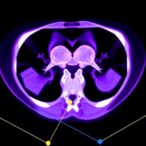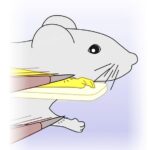
A team at the Centro Nacional de Investigaciones Cardiovasculares (CNIC) has developed an innovative method known as TEVs-TTN, for studying the specific mechanical functions of proteins through their controlled cleavage. This process renders the proteins unable to sense and transmit mechanical force. The study, headed by Jorge Alegre-Cebollada, PhD, demonstrates that interrupting mechanical transmission by the protein titin precipitates muscular diseases. This finding opens new routes to understanding muscular dystrophies and other diseases associated with this protein.
Alegre-Cebollada and colleagues reported on their findings in Nature Biomedical Engineering, in a paper titled “Mechanically knocking out titin reveals protein tension loss as a trigger of muscle disease.” In their paper the authors stated, “Here we demonstrate that cessation of force transmission across titin results in severe muscle atrophy and dysfunction correlating with gradual sarcomere depletion…Our findings suggest that slack titin molecules drive muscle disease, potentially through mechanisms shared with other mechanical proteins.”
Titin, named after the titans of Greek mythology, is the largest protein in animals and plays a critical role as the structural linchpin of sarcomeres, the contractile units of muscle cells. “Titin, the elastic protein scaffold of muscle sarcomeres, has multifunctional roles in mechanosignaling and is implicated in muscle disease,” the authors noted. Mutations in the titin gene (TTN) are a leading cause of congenital muscular diseases and cardiomyopathies, added first author Roberto Silva-Rojas, PhD. “Many of these mutations generate a prematurely truncated form of the protein, impeding its correct anchoring in the sarcomeres and disrupting muscle function.” The team further noted, “Consistent with the fundamental functions of the protein, truncating variants in the titin gene (TTN) are responsible for many severe diseases, including dilated cardiomyopathy and congenital myopathies.”
The term titinopathies is now used to refer to many forms of muscle disease when they are caused by titin mutations. “Together with the different types of heart disease triggered by titin variants, the existence of titinopathies makes TTN an important human disease gene,” the scientists stated. However, they commented, “… the underlying molecular mechanisms of these pathologies remain largely unknown.”
To dissect the functional role of titin mechanics, the team carried out site-directed cleavage of the protein by heterologous expression of tobacco etch virus protease (TEVp) in living mice. “This strategy, which we name titin mechanical KO (mKO), results in loss of force transduction across titin’s polypeptide backbone while preserving the total levels of the protein and therefore its non-mechanical functions,” they explained.
Using this system the CNIC team was able to replicate the sarcomere disorganization typical of patients with titin mutations. As Silva-Rojas explained, muscles with cleaved titin showed similar defects to those observed in patients, including cell-volume reduction, nuclear internalization, mitochondrial aggregation, and interstitial fibrosis. “Our results reveal that titin mKO muscles develop a severe form of myopathy recapitulating a number of structural, histological and functional phenotypes in human patients who carry pathogenic TTN variants,” the investigators noted.
![TEVs-TTN is a tool that permits the controlled cleavage of titin in mice. The confocal and electron microscopy images show that titin cleavage in muscle triggers disassembly of sarcomeres, and the staining with hematoxylin and eosin (H&E) and succinate dehydrogenase (Mitochondria) reveal myofibril atrophy, nuclear internalization, and mitochondrial aggregation. Image partially created with BioRender.com [CNIC]](https://www.genengnews.com/wp-content/uploads/2025/06/Low-Res_FiguraNotaPrensa-300x238.jpg)
“In the absence of experimental animal models with titin-cleavage mutations, our approach allows a structured and targeted analysis of the impact of these types of alterations. This makes TEVs-TTN an ideal tool for testing therapies designed to mitigate the effects of impaired sarcomere integrity.”
One intriguing finding of the study was that titin cleavage caused complete disintegration of sarcomeres over the course of a few days, leaving muscle cells devoid of their basic functional unit within seven days post infection (dpi). “Altogether, immunofluorescence and ultrastructural characterization confirm that titin cleavage by TEV protease results in mechanical unloading of the protein preceding sarcomere disassembly,” the investigators reported. “As a result, many myofibers in titin mKO muscles are fully devoid of sarcomeres from 7 dpi.” Nevertheless, these cells survived, suggesting that similar processes might operate in other situations, such as muscle tears, heart failure, or cardiotoxicity associated with chemotherapy.
The methodology developed at the CNIC marks a milestone in the study of how protein mechanics contribute to tissue and organ physiology. “Our work demonstrates the use of TEVp to achieve protein mKOs in vivo, that is, ceased force transduction across the targeted protein with no alteration of protein levels,” they pointed out.
Just as titin is critical for force transmission in sarcomeres, other proteins, such as dystrophin, dystroglycan complexes, integrins, and lamins, play critical roles in extracellular matrix regulation and cell membrane integrity. “Taking into account enticing observations using optogenetics to mechanically knock out proteins in vitro, the protease-based strategy that we describe here could be exploited to dissect the complex functions of other mechanical proteins, including pathomechanisms of mutant proteins relevant for human disease such as dystrophin, nebulin, integrins, lamins and cadherins.”
The new tool will enable the research team to confirm or refute hypotheses about the functioning of these proteins. These advances, in turn, could pave the way to the development of new therapeutic strategies for many diseases beyond those affecting muscle.



